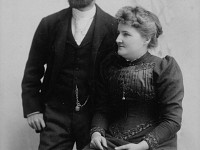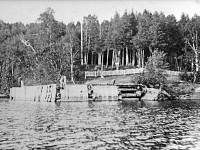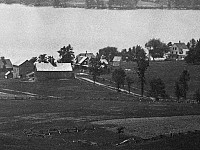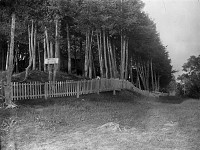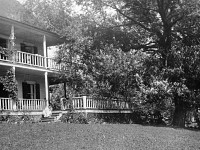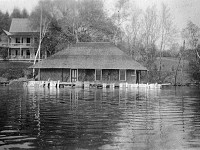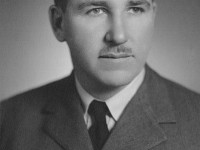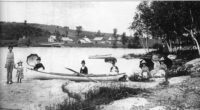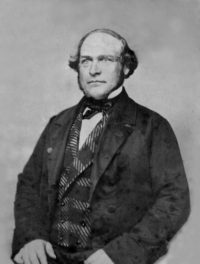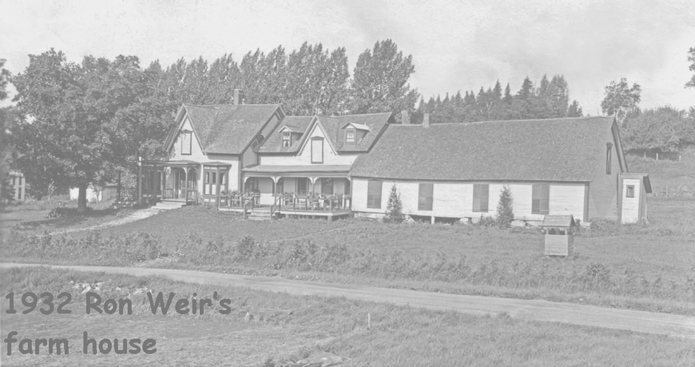
The history of Cedarville is surprisingly interesting for such an inconsequential place!
The briefest of notes as they pertain to the property on which Solarhurst has been built are presented here.
The Province of Lower Canada had established a Customs and Revenue office (Port) in Stanstead County as early as 1821, to oversee traffic on the stagecoach route from Montreal to Boston, but by and large this presence did little to impede movement of goods or people across the ill-defined (and little respected) frontier. In 1844 the government sought to limit this defacto “free-trade” by the establishment of a far more extensive system of Customs ports throughout the Eastern Townships … an initiative that met with precious little local approval!
In the months between break-up and freeze-up, a brisk trade was regularly carried on over the international waters of Lake Memphremagog, principally in timber and sawn-lumber. The Lake was a far more expedient and efficient highway for the movement of large quantities of goods, and with the introduction of steam powered navigation to the Lake in 1850, this advantage was amplified. By the mid-1860’s two steam boats with relatively large cargo capacities were regularly plying the Lake, the Mountain Maid and the Stars and Stripes, and plans had been laid to construct and launch and even larger vessel, the Lady of the Lake. In Georgeville, where a steamboat wharf was located, a custom’s port had been established in 1853 to oversee this water-borne trade. In 1864 a further custom’s office was established at Magog (then known as the “ Outlet “), and both Georgeville and Magog were constituted subports of the Port of Stanstead. The problem with locating custom’s officials at either Georgeville, or worse yet Magog, was that these ports were situated at least 15 miles to the north of the international border, and steamboats coming from Newport commonly docked on the Canadian side at the Mountain House and/or Knowlton’s Landing prior to arriving at Georgeville. This arrangement clearly could be, and was, abused, aided and abetted by the steamboat operators themselves. Such a flagrant circumvention of the law could be tolerated for only so long, and in 1864 officials in Quebec concurred that it was necessary to establish a custom’s subport closer to the line.
The relatively mountainous terrain on the west side of the Lake was poorly accessible and for this reason inappropriate for locating a Custom’s subport. The east side of the Lake has far less relief and was at least populated sporadically by second generation farmers. Furthermore a network of rough roads traversed this countryside connecting Fitch Bay, Georgeville, Stanstead and Beebe. Some of the first settlers in this area had farms with lake frontage, and at several localities they had built wharves or “landings” to accommodate traffic on the Lake. One such wharf had been built by the settler David Harvey (having arrived in Stanstead County in 1805), and was known appropriately enough as “Harvey’s Landing”. It was originally contemplated that the new subport could be established at, or at least in the near vicinity of, Harvey’s Landing. Ultimately this site was rejected, and one can only speculate that a right-of-way could not be secured, or that Harvey’s Bay close to shore was too shallow to accommodate the large steamers which would be required to dock there. In any case the subport was built instead some distance to the southeast from Harvey’s Landing at a point of land on property owned by the farmer Daniel Noake. It was here that Cedarville’s history began.
In 1865 David Moir and others constructed a steamboat wharf on farmer Noake’s point (the point property where Penny and John Logan now reside). For a while the first subcollector of customs at the new subport, a Mr. Matthew Dixon, had a small building erected on the wharf for use as a combined boathouse and office. He and his family rented space for dwelling in Noake’s farmhouse (which is still standing). In 1866 Dixon purchased a lakeshore lot (a large portion of which became the Solarhurst lot), with the intention of building a proper dwelling house for his family, and to also serve as a custom’s office. For reasons that are still unclear, Dixon never built his house. In 1872, when Dixon was no longer subport collector at Cedarville, a custom’s office was finally built, though not on his land. Instead tit was erected right on the point about 75m northeast of the wharf. This custom’s house survived (albeit in a new location) for well over a century but was torn down in the 1990’s. In the late 1870’s some enterprising souls built a small country hotel on the old Dixon lot in order to take advantage of the steamboat traffic and custom’s subport. It proved to be a “white elephant”, for no sooner was the hotel completed, then the custom’s subport was closed. With no requirement to report to customs, and no significant business to effect there, the steamboats stopped calling at the wharf, resulting in no patrons for the hotel.
At this point in time Jeff’s family comes into the picture. His great-great-grandfather, Alexander Douglas, who was a moderately well-off shoe store owner in Montreal, invested in the steamer, the “Lady of the Lake”. Family legend has it that he was on the inaugural voyage. In any event he fell in love with the Lake Memphremagog region, and may well have spent some time at the Cedarville hotel. After he died, his wife and grown-up children started renting the empty hotel for summer holidays. In particular his daughter Margaret (Gertie to her friends and family) and his son-in-law, Robert Stanley Weir, became enchanted with the local area, and in 1900 Robert purchased the hotel property and named his new summer residence, “Cedarhurst”. Judge Weir wrote the English words to O Canada at Cedarhurst in 1908, and he died at his beloved summer retreat in 1926. The Judge’s youngest son, Ronald Weir kept up Cedarhurst during his lifetime, and in the early 1930’s bought the Bullis farm, which effectively incorporated all of Echo Bay. Ronald died in service in France in 1944. Weir Memorial Park was a bequeath of Ronald’s to the local communities, in order to provide their residents with access to the Lake (all of whose shoreline was privately owned by this time), and to honour his mother and father.
By 1946 the old hotel had been severely vandalized and was showing her age, and so was torn down. The foundations of the old hotel now serve as a sunken garden just to the south of our present building.
Many families in the Ogden area are descendants of Alexander Douglas, including Baker, Elliott, Douglas, May, Simpson, Foulkes, Stairs, and Packard.

